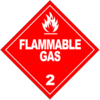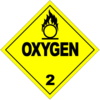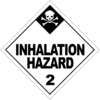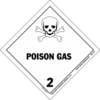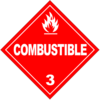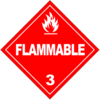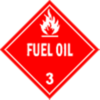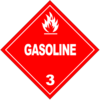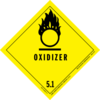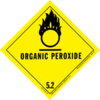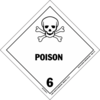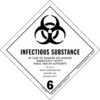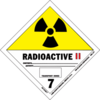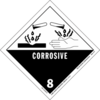
Hazardous materials information
Dangerous goods
A dangerous good is any solid, liquid, or gas that can harm people, other living organisms, property, or the environment. An equivalent term, used almost exclusively in the United States, is hazardous material (hazmat). Dangerous goods may be radioactive, flammable, explosive, toxic, corrosive, biohazardous, an oxidizer, an asphyxiant, a pathogen, an allergen, or may have other characteristics that render it hazardous in specific circumstances.
Mitigating the risks associated with hazardous materials may require the application of safety precautions during their transport, use, storage and disposal. Most countries regulate hazardous materials by law, and they are subject to several international treaties as well.
Persons who handle dangerous goods will often wear protective equipment, and metropolitan fire departments often have a response team specifically trained to deal with accidents and spills. These teams train with different organizations at a variety of specialized locations. Some of the most well-known in the U.S. and Canada include the California Specialized Training Institute, the Texas A&M TEEX Academy, Signet North America, the Justice Institute of British Columbia, and the U.S. National Fire Academy.
Laws and regulations on the use and handling of hazardous materials may differ depending on the activity and status of the material. For example one set of requirements may apply to their use in the workplace while a different requirements may apply to spill response, sale for consumer use, or transportation. Most countries regulate some aspect of hazardous materials.
The most widely applied regulatory scheme for the transportation of dangerous goods is that of the The Committee of Experts on the Transport of Dangerous Goods of the United Nations Economic and Social Council issues: Model Regulations on the Transportation of Dangerous Goods. Most regional and national regulatory schemes for hazardous materials are harmonized to a greater or lesser degree with the UN Model Regulation. For instance, the International Civil Aviation Organization has developed regulations for air transport of hazardous materials that are based upon the UN Model but modified to accommodate unique aspects of air transport. Individual airline and governmental requirements are incorporated with this by the International Air Transport Association to produce the widely used IATA Dangerous Goods Regulations. Similarly, the International Maritime Organization has developed the IMO Dangerous Goods Regulations for transportation on the high seas. Many individual nations have also structured their dangerous goods transportation regulations to harmonize with the UN Model in organization as well as in specific requirements.
Dangerous goods are divided into classes on the basis of the specific chemical characteristics producing the risk.
Note: The graphics and text in this article representing the dangerous goods safety marks are derived from the United Nations-based system of identifying dangerous goods. Not all countries use precisely the same graphics (label, placard and/or text information) in their national regulations. Some use graphic symbols, but without English wording or with similar wording in their national language. Refer to the Dangerous Goods Transportation Regulations of the country of interest.
Class 1 hazardous materials
 |
 |
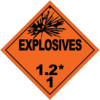 |
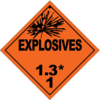 |
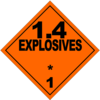 |
 |
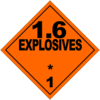 |
1.1 |
Explosives with a mass explosion hazard. (nitroglycerin/dynamite) |
|---|---|
1.2 |
Explosives with a blast/projection hazard |
1.3 |
Explosives with a minor blast hazard. (rocket propellant, display fireworks) |
1.4 |
Explosives with a major fire hazard. (consumer fireworks, ammunition) |
1.5 |
Blasting agents |
1.6 |
Extremely insensitive explosives |
